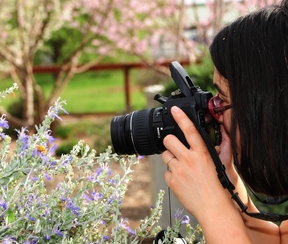
This is Xylocopa varipuncta, also known as "the teddy bear bee."
It's a green-eyed blond and as fuzzy as any teddy bear you'll ever have the pleasure of meeting. Native pollinator specialist Robbin Thorp, distinguished emeritus professor of entomology at UC Davis, calls them "teddy bear bees" and the name has stuck. (And being "boy bees," they cannot sting. See close-up photo on Bug Squad.)
Scampavia, who is studying how farming practices affect bee nesting for her doctorate in entomology, recently won the top graduate student poster award at the first-ever UC Davis Bee Symposium, and provided the popular “Pollinator Pavilion” at the UC Davis Picnic Day.
She urges us to all pitch in and protect the pollinators. Good advice.
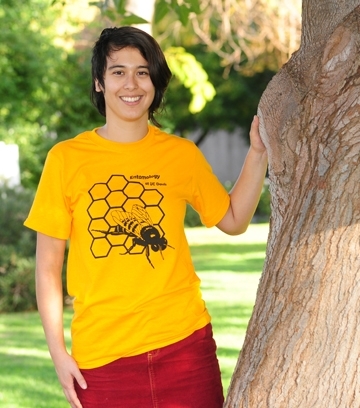
Scampavia, who studies with major professors Neal Williams and Ed Lewis of the UC Davis Department of Entomology and Nematology and anticipates receiving her Ph.D. in 2016, lists three ways to “save the pollinators."
1. Provide food: Plant a variety of trees, shrubs and annual flower with blooms that differ in size, shape, color and flowering time. Planting native milkweeds also can help support monarch butterfly populations. Hummingbird and butterfly feeders can also provide additional food sources, but make sure to clean and disinfect your feeders regularly, as they can accumulate toxic fungi.
2. Provide homes: Bees can be limited by food or nesting opportunities. Native bees are usually not aggressive and unlikely to sting. A patch of bare soil can provide valuable nest sites for soil-nesting bees, particularly if the soil is loose and slightly damp. A dead stump or log, or shrubs with hollow stems, such as raspberry or elderberry, can also provide nests for cavity-nesting bees. “You can also make or order a ‘bee condo,' or a block of wood with holes of varying diameter,” she says. “Line these holes with paper tubes to make them easy to clean between years. Some bee species line their nests with rose, wisteria or fuzzy plants such as lamb's ear leaves, so growing these plants can help these bees, too.”
3. Provide pesticide shelters. As much as possible, try to reduce pesticide use in your garden, or use less toxic pesticides, such as soap sand oils. If you spray, do so when pollinators are not active--after dusk to before dawn. Try to avoid spraying flowers directly. Create a pesticide-free source of water and mud for bees and butterflies, such as a dripping faucet or a bird.
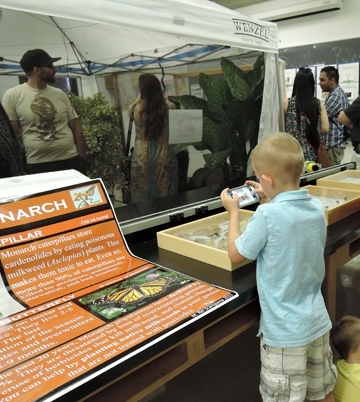
Her display showcased numerous live pollinators, including bees, butterflies and flies. She also drew in the crowds with informational posters on pollinators. The posters detailed how individuals can help support healthy pollinator populations.
Visitors could walk inside the zipped enclosure and be one-on-one with the pollinators, including the monarchs, blue orchard bees, and syprhid flies. Many took photos of the monarchs on their hands or arms. Younger visitors were encouraged to practice observing pollinators by filling out a data sheet counting the number of each type of pollinator they saw.
Scampavia recently won the top prize at the Bee Symposium with her poster, “Farming Practices Affect Nest Site Selection of Native Ground Nesting Bees.”
"Rei is mutli-talented: she is able to both conduct high quality research and communicate information about pollinators in engaging and effective ways," said Katharina Ullmann who holds a doctorate in entomology from UC Davis (Neal Williams lab) and is now a crop pollination specialist for the Xerces Society for Invertebrate Conservation. "Anyone who saw her award-winning poster at the Bee Symposium or who experience the pollinator pavilion at Picnic day knows that pollinators are lucky to have Rei working for them!"
Scampavia received her bachelor's degree in biology in 2008 from Mills College, Oakland. She began her doctoral studies at UC Davis in 2011. She earlier served as a biological science technician (plants) for the U.S. Forest Service, Groveland, Calif., and ; a research consultant for BMP Ecosciences in San Francisco.
Active in the Entomological Society of America (ESA), Scampavia was a member of the 2014 UC Davis Student Debate Team that won first place in the nationals. She also was a member of the 2013 UC Davis Linnaean Games Team that won second at the annual meeting of the Pacific Branch of ESA.
If you want to meet Rei Scampavia and "talk bees," she'll be volunteering at the Häagen-Dazs Honey Bee Haven open house from 5:30 to 7 p.m., Friday, June 19. The haven, managed by staff director Chris Casey and faculty director Elina Niño, Extension apiculturist, is located on Bee Biology Road, next to the Harry H. Laidlaw Jr. Honey Bee Research Facility, west of the central campus.
The half-acre bee garden, operated by the UC Davis Department of Entomology and Nematology, is filled with blooms, bees and butterflies! The open house, free and open to the public, will include bee observation and identification, honey tasting, sales of native bee houses to support the haven, and information about low-water plants.
The garden is open to the public daily from dawn to dusk.
Attached Images:
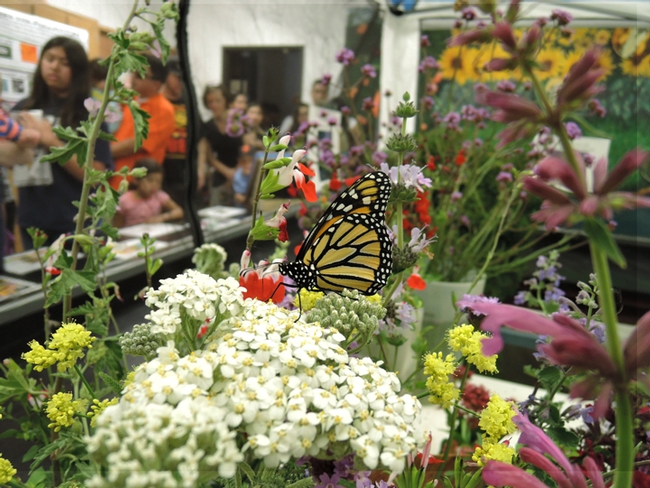
It was a mix of pollinators and people at the Pollinator Pavilion during UC Davis Picnic Day. Graduate student Rei Scampavia provided the display in Briggs Hall. (Photo by Kathy Keatley Garvey)
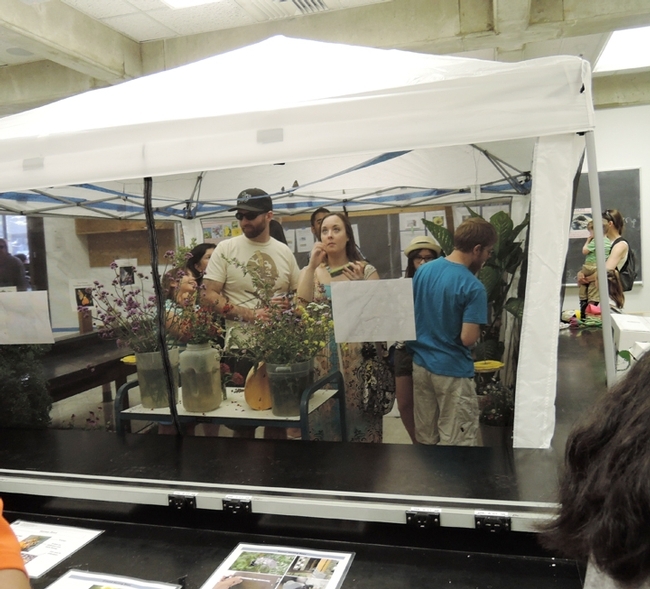
Visitors at the Pollinator Pavilion, UC Davis Picnic Day, could could get up close and personal with the pollinators in a zipped enclosure. (Photo by Kathy Keatley Garvey)
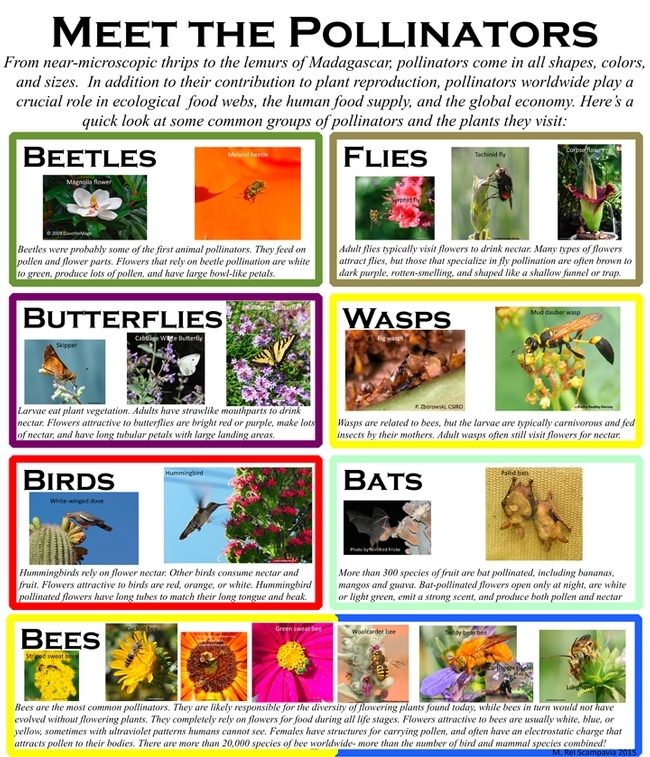
This poster by Rei Scampavia showcases the many species of pollinators.